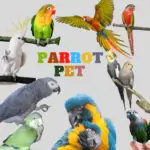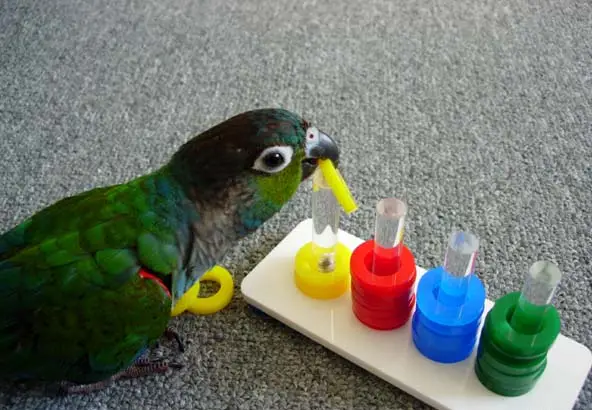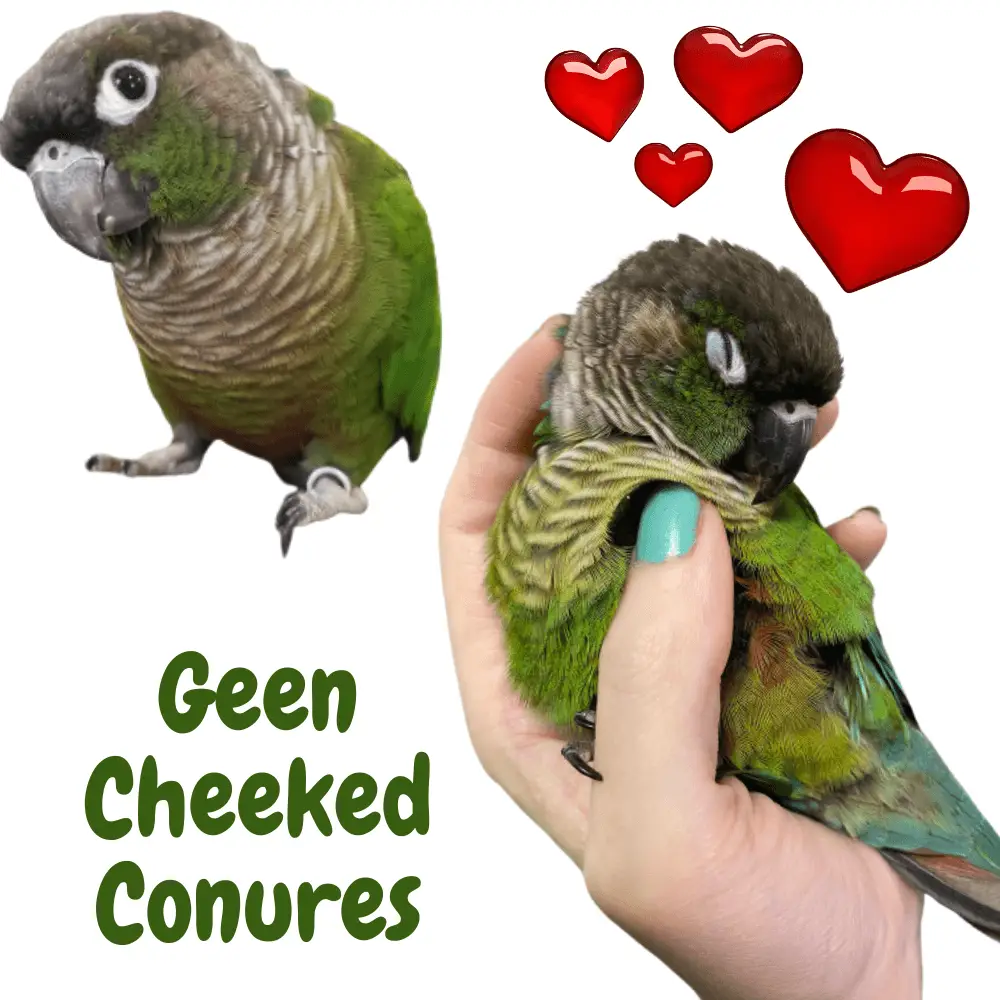
The green cheeked conures (Pyrrhura molinae) or green cheek parakeet is a species of parakeet that measures about 25 cm from head to tail in adulthood. Its plumage is predominantly green, mainly on the head, hence its other name “Green-cheeked Parakeet”.
Her life expectancy in captivity can be up to 25 years, even 30, if raised in the right conditions.
The Green cheeked conures have been kept as companions or farmed birds for decades. Documents attest to their captivity since the beginning of the 20th century.
However as the adventure gradually turned from the menagerie into a serious “hobby”, the Pionus has long been ignored by the majority of poultry farmers. From 1980 there was a positive explosion of interest in keeping and raising parrots.
During this period, techniques for the success of captive breeding made a big leap in their efficiency and allowed an increase in the breeding of many species.
- The different species (or breeds)
The Green-cheeked conures, originating from the Neotropics are of medium or small size. They are slightly stocky birds that are distinguished from their closest parents by several physical characteristics such as their large eyes bordered by very exposed peri-ophthalmic skin, their short tails and the triangular patch of red feathers in the abdominal region.
- The characteristics
They also have a particular odor although it is not very very strong or unpleasant in their natural environment. The behavioral characteristic which perhaps distinguishes them is their breathless breathing or even asthmatic when they are excited or stressed.
This noise first heard by a new owner worried and worried him until he realized that this particular breathing was normal.
- The eight subspecies of Green-cheeked conures
Here is the list of the main species of Green-cheeked conures, you can click on the species that interest you to discover a more complete article on the subject: Conure Species
Green cheek conure size
Green cheek conure lifespan
How long do green cheek conures live:It is a bird native to South America. It is more precisely found in Brazil, Bolivia and Argentina. It measures approximately 26cm (from the top of the head to the end of the tail) and weighs approximately 70 grams. Its life expectancy in captivity can be up to 30 years.
In the wild, it is a bird that lives in forests and is usually seen in large flocks at the top of trees. It is not uncommon to see groups of twenty or more. They feed mainly on seeds, berries, fruits, nuts, various vegetation and insects.
Green cheek conure price
How much does a green cheek conure cost:Prices for Green Cheek Conures Parrot are on average around $375, but the range is fairly large, starting from $250 on the lower Depending on the type of conure and where one is bought, prices vary.
Green cheek conure habitat
The Molina Parakeet lives in the wild in South America. The species is divided into 5 subspecies, differentiated by the location of their habitat and variations in the colors of the feathers:
- 1 subspecies lives in the primary forests of eastern Bolivia,
- another sees its living area distributed between northeastern Bolivia and central-western Mato Grosso (Brazil),
- another is located in the south-east of Mato Grosso,
another in the regions of Palmaito and Chiquitos in Bolivia, - and a final one in the northeast of Argentina.
- hypoxantha mutation: the flanks of the bird are mainly yellow and the red color on the belly is reduced,
opaline mutation: increased red color on the belly, - cinnamon mutation: the head is between white and very light brown,
- opaline cinnamon mutation: the mutation is also called “pineapple” because the bird has a light head and a more or less red belly,
- turquoise mutation: the belly is no longer red at all and the bird is generally greenish blue,
- opaline turquoise mutation: the bird is greenish blue with a small presence of red on the belly,
- cinnamon turquoise mutation: the mutation is also called “silver”; the bird’s plumage is predominantly light with slightly blue wings,
- turquoise opaline cinnamon mutation: the mutation is also called “blue pineapple”; this is the cinnamon turquoise version with a little red on the belly,
- misty mutation: the bird has darker plumage than the others,
- dilute mutation: the bird’s plumage is pastel with brighter colored wings,
- suncheek mutation: it combines the characteristics of opaline, cinnamon and dilute. The bird has a red tail and chest but a pale head, yellow sides and greenish yellow wings,
- mint mutation: it is a combination of turquoise and dilute mutations; the bird is mint water color,
- lutino mutation: the bird is all yellow with red eyes.
Green cheek conure mutations
A Molina Parakeet generally responds to the following description: predominantly green plumage, breast covered with dark brown and light golden scale feathers, black forehead, crown, nape, beak and legs, blue flight feathers, red tail, white eye circles and brown iris.
The plumage and the color of its eyes can be different, however, without constituting a distinct subspecies. Indeed, in parakeets, it is not uncommon to observe a mutation, a term which designates a change in the physical characteristics of the young compared to the characteristics of the pair of parents.
The mutation is a genetic modification visible from birth. Here are different mutations observed in the Molina Parakeet:
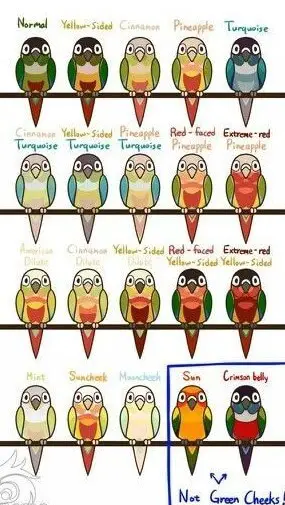
Are conures smart
Belonging to the parrot family, this little bird is intelligent like all the birds of this large family. He is extremely curious and likes to observe his surroundings carefully.
Quickly understanding the meaning of gestures, the Pyrrhura molinae can beg their owner for treats. They can also do silly things, such as undoing the links of various objects attached to the cage. More annoying or even harmful, they can open the hatches of the cage. So you have to keep an eye on them!
It is all the more important to teach them some basic commands. Given their intelligence, learning will be quick, but it will require regular maintenance. The most important of these is the “Step-Up” command which trains the bird to get on its owner’s finger. This will allow you to get the bird out of its cage.
The recall is the other essential command: it consists in making the bird come to you, either by words, or by sounds or gestures. This will make it easier for him to return if he runs away outside.
Green cheek conure personality
SOURCE:geobeats
Green cheek conure care
Conure care:It is a bird that requires a lot of attention. A bored Molina’s Parakeet will live less long: it needs to be stimulated by a variety of interactions. If the bird is alone, you will have to play with it and provide it with toys and objects to gnaw on (to be renewed regularly).
Acquiring several specimens allows the birds to have fun with each other. But obviously, it makes more noise. Because this bird manifests itself regularly throughout the day by vocalizations, to make itself understood or to express its discontent and its desires. This can become tiring over time.
It is therefore essential to think carefully before deciding to acquire one or more Pyrrhura molinae.
Green cheek conure adoption While the beauty and brains of the green-cheeked conure make them an attractive pet, the truth is, not everyone has what it takes to own a conure or a bird.
Before you bring home a green cheeked conure, do plenty of research to make sure that you will be able to meet the needs of your new companion.
Can you afford a spacious bird cage and do you have room in your home?
Do you have extra money to set aside for emergency vet visits?
Can you spend two to four hours a day supervising and interacting with your parrot during games and exercises outside of the cage? If you can’t answer these questions with a steadfast “yes”, chances are a parrot isn’t the right pet for you.
In its natural environment, the green-cheeked conure usually lives in small groups of 10-20 birds, and in captivity it always requires considerable social interaction, which must be provided by the owners.
Those who are able to provide for a green-cheeked conure receive a loving and dedicated little animal in return. Many people who have a green conure on their cheeks decide that no other species of bird will. These little birds really steal hearts.
Before buying a conure from a bird store or breeder, be sure to check out animal shelters and rescue organizations. While the soft, easy-to-maintain design isn’t often offered up for adoption, there are times when owners are forced to give up their birds.
A green cheeked conure doesn’t require the kind of space a larger parrot needs, but you should plan for a fence that is at least 24 square inches and 30 inches high, with metal bars spaced 1 / apart. 2 to 3/4 inch. As with any parrot, a larger cage is always better.
Plan for several perches at least 9 inches long and 1/2 inch in diameter – a variety of perch sizes will help keep your parrot’s feet flexible.
Green-cheeked parrots pair well with other green-cheeked, but do not harbor them with different species. Of course, two birds will require a much larger cage.
Like all birds, green cheeks can be limp and uncooperative at times, but as a rule, they are among the more easy-going species of conures. Although most never speak, green-cheeked conures do well with training and are known to learn quickly. This willingness to learn plays an important role in the popularity of the green cheek today.
Conure Care | A Complete Guide
SOURCE:Happy Tails
Green cheek conure diseases
It is necessary to regularly monitor the health of your Green-cheeked conures, because certain diseases can be fatal or very harmful for it. Discover our file on Green-cheeked conures diseases.
We present you the symptoms and the possible treatments, we also present you the necessary equipment to care for your pets.
Green cheek conure health
It is important to clean the bottom of the cage and the buckets on a daily basis. The water should be changed every day and the buckets should be scrubbed well to remove deposits. Also make sure the food is fresh. Once a week, it is recommended to clean the entire cage.
You can wash in hot water with a mild detergent, such as dish detergent. Rinse well.
CAUTION DANGER, DO NOT GIVE!
- Avocados, fruit stones and seeds, tomato plants, rhubarb leaves, chocolate, coffee, butter, fatty foods, salt, sugar or alcohol.
- Many house plants are poisonous if ingested.
- Avoid gravel, birds shelling their seeds do not need gravel. Overuse of gravel can cause clogging, possibly even causing death.
- Teflon pans, all chemicals, cigarettes.
- Gold and silver “jewel”
- Cages made with galvanized grid
Green cheek conure talking
SOURCE:Pet Anything
Green cheek conure colors
Green cheek conure mutations table Many of you are confusing a mutation and a species. Here is the complete list of green cheek conure mutations, all other conures are from another separate species. Oisellerie PLB breeds all the mutations below.
Normal- wild type; Green cheeked conure is a green bird, with a black head, black beak, black feet, blue flight feathers, and a wine red tail.
Opaline (Yellow Side) – From the back it has the same dark green color as the wild type. the color of its tail can vary in coloration from wine red to light red. On the side of the breast, it has a beautiful yellow stripe and has a black bill and white feet.
Cinnamon (cinnamon) – The color green is pale, the blue of the flight feathers its pale blue. The color of the bill, head and feet are white.
Pineapple (pineapple) – This is a visual blend of a Yellow Side and a cinnamon. It has a cinnamon head and striking yellow sides, and its green coloring is pale as cinnamon.
Turquoise- this bird is a dark turquoise blue. The turquoise gene is resesive, so both parents must be a carrier to give babies visual turquoise. All mutations can be seen in variety turquoise, Normal turquoise, Cinnamon turquoise, Yellow Side turquoise, pinapple turquoise.
American Dilute- this is a cream colored bird that is different from cinnamon in that it has a dark bluish beak and black feet. He has dark eyes and has white fluff when he is young.
The American dilute gene is recessive like the turquoise gene, both parents must be carriers to have visual dilute chicks.
Mint- this is an American visual dilute turquoise. He is a new very pastel color with a silver head and a platinum tail. He has eyes, feet and beak therefore.
(two visual recessive genes)
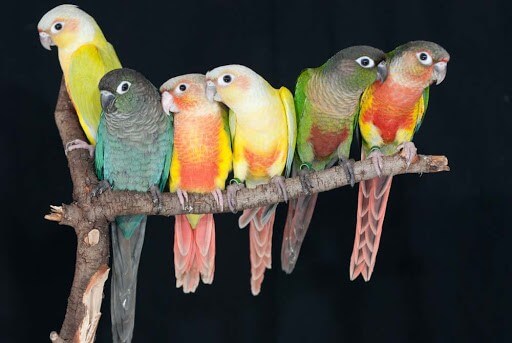
American Dilute yellow side– It looks a lot like a Jandaya Conure! It has a black bill and feet with rich red and yellow colors from the Yellow Side and a light cream color from the American Dilute. (recessive dilute gene)
American Dilute Cinnamon– this is a very light cream bird with white feet and white and cream colored, almost white beak. (Cinnamon linked to sex and Dilute ressesive)
Sun Cheek (American Dilute pineapple) – This is yellow on the chest,like sun conure, thighs and back with a red on the lower chest infusing the upper part of the neck. It has ruby colored eyes, white feet and beak, and a cream head. It is a Yellow side – American Dilute – Cinnamon. (sex related and recessive)
Moon Cheek (American Dilute pineapple turquoise) – This is a light blue bird with almost a white breast. It has no red pigment and has a white bill and white feet. It is a visual turquoise – American Dilute – Yellow side – Cinnamon. This is a Cheek Sun, plus the Turquoise mutation. (sex-related is recessive)
Yellow-Side Mint (American Dilte yellow side turquoise)
Cinnamon Mint (American Dilute Cinnamon turquoise)
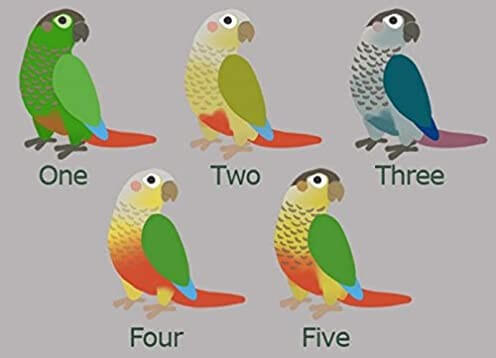
Green cheek conure diet
Pyrrhura molinae are seed and fruit eaters.Regarding seeds, industrial mixtures for large parakeets are quite suitable.
On the fruit side, you can make a pâté yourself from egg and vegetables and / or fruit cut into small pieces and mixed.
Small individual pieces can also be given to peck, according to the seasons: apple, grape, peach, kiwi, carrot, zucchini, cucumber, etc.
Remember, of course, to provide the bird with plenty of clean, fresh water.
If your Pyrrhura molinae reproduce, you must increase the vitamin intake during the breeding season: sprouted seeds, ready-made vitamin supplements. Calcium is also important for the female: a cuttlebone must be made available before and after spawning.
The feeding of the Green-cheeked conures:Green-cheeked conures cannot eat everything that humans eat, even if they seem to love. Certain foods are harmful to them. Discover a complete file on the feeding of the Green-cheeked conures, with the recommended foods and those which must absolutely be avoided.
Beaphar Care + high quality energy granules Beaphar Care + (for Gabonese gray) energy granules Beaphar Pasta Universal cereal paste for parrots
Feeding green cheek conure
In the wild, green-cheeked conures feast on fruits, vegetables, seeds, and the occasional insect. Animals captured in captivity should follow a similar diet:
For optimal health, feed your conure a wide variety of fresh fruits and vegetables, supplemented with a high quality granulated diet, and try to make life easier and healthier. for your health. bird. This will provide your conure with the best foundation for lifelong health and happiness.
Breeding Green-cheeked conures
The best way to breed Green-cheeked conures is to do it naturally, by naturally we mean respecting their natural habits and needs, with real nest, these breeding cycles must be respected correctly and a correct pairing of couple.
Discover tips to manage your Green-cheeked conures breeding and to make sure to provide the Green-cheeked conures with everything they need in terms of space, food and environment.
Although very complex, artificial Green-cheeked conures breeding can work and is practiced by several poultry farmers.This requires some experience and to be equipped with the right equipment.
Parrot Hormones and Mating Behaviors
SOURCE:Guide to Green Cheek Conures
Green cheek conure natural habitat
- Green-cheeked conures menstruus → Brazil, Bolivia, Colombia, Guyana, Guyana, Suriname, Peru
- Green-cheeked conures sordidus → Venezuela, Colombia, Peru, Bolivia
- Green-cheeked conures maximiliani → Brazil, Bolivia, Paraguay, Argentina
- Green-cheeked conures tumultuosus → Peru
- Green-cheeked conures senilis → Panama, Mexico
- Green-cheeked conures chalcopterus → Venezuela, Colombia, Peru
- Green-cheeked conures fuscus → Venezuela, Guyana, Guyana, Suriname, Brazil
To breed a Green cheeked conures, the passion for this little colored bird unable to speak must absolutely prevail over financial interest. It is for this reason that we find more breeders of African Grey Parrot and Macaw than breeders of Pionus.
We are therefore going through these few pages to try to make you discover this South American species neglected from French breeding.
John Stoodley, Green-cheeked conures specialist
The Green-cheeked conures species was not very widespread until many growers in North America and Europe took a specific and concentrated interest in this species of birds from the South American continent.
At the forefront of this evolution in favor of increased knowledge of the Green-cheeked conures in captivity was then John Stoodley.
Green cheek conure cage
Your bird’s cage is his home; it is his dining room, his playground, his “bottom of the cage” toilet and, when you cover the cage for the night, it is his bedroom.
It is always best to have a rectangular or square cage, large enough for your bird to spread its wings well and climb. Buy the largest cage possible, as this is where your bird will spend most of the time when you are away.
Green cheek conure cage size
The Molina Parakeet is an active bird that likes to move around. It therefore needs a minimum of space: for a single individual, the cage must be at least 70 cm wide by 60 cm high and 40 cm deep. When there are several birds, the width stretches to 120 cm wide for the same height and depth.
Placing nests in the cage is essential because Molina’s Conures like to sleep there, even outside the breeding season.
Green cheek conure cage setup
Perch:It is better to have perches of different diameter. Maple, birch and manzanita wood perches make excellent, indestructible perches. It is also good to place some perches in soft “pine” wood to allow the bird to chew them; this promotes normal wear and tear on his beak and occupies his waiting for your return.
The perch also serves as a napkin since your parrot will clean the beak there; it is therefore important that it is clean. Wash your perches and dry them in the oven at 80 ° C for 15 minutes “let them cool before putting them back in the cage”
Green cheek conure toys
Toys are essential for the good mental and physical health of your bird. When you’re away from home or just needs to stay in his crate, toys are his distractions, his source of exercise, and they too contribute to the natural wear and tear of his beak.
Choose toys suited to the strength of your parrot’s beak. It is recommended to vary them by making a rotation, by changing them of place in the cage. If they are soiled, they must be washed.
Interactive Parrot toys
Green cheek conure breeding
The conure is very profolic and produces between 4 to 6 eggs like most pyrrhura. Age of reproduction: To be more effective the green-cheeked conures must be mature and preferably over 1.5 years.
As a companion bird, at this age, he may be more dominant, but it is a phase that will pass and with the advice of your breeder, you can get him through this adolescent crisis.

